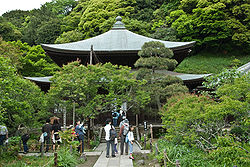
Kamakura's proposed World Heritage sites
Encyclopedia


Kamakura, Kanagawa
is a city located in Kanagawa Prefecture, Japan, about south-south-west of Tokyo. It used to be also called .Although Kamakura proper is today rather small, it is often described in history books as a former de facto capital of Japan as the seat of the Shogunate and of the Regency during the...
has proposed some of its historic site
Historic site
A historic site is an official location where pieces of political, military or social history have been preserved. Historic sites are usually protected by law, and many have recognized with the official national historic site status...
s to be inscribed as a UNESCO
UNESCO
The United Nations Educational, Scientific and Cultural Organization is a specialized agency of the United Nations...
World Heritage Site
World Heritage Site
A UNESCO World Heritage Site is a place that is listed by the UNESCO as of special cultural or physical significance...
. The sites are:
- The - One of Kamakura's Seven EntrancesKamakura's Seven EntrancesThe city of Kamakura, Kanagawa in Japan, is closed off on three sides by very steep hills and on the fourth by the sea: before the construction of several modern tunnels and roads, the so-called Seven Entrances , or were its main links to the rest of the world...
- The - One of Kamakura's Seven Entrances - One of the oldest shrines in Kamakura, it enshrines Sugawara no MichizaneSugawara no Michizane, also known as Kan Shōjō , a grandson of Sugawara no Kiyotomo , was a scholar, poet, and politician of the Heian Period of Japan...
- Rinzai temple in Kita-Kamakura, number two of Kamakura's Five MountainsFive Mountain SystemThe system, more commonly called simply Five Mountain System, was a network of state-sponsored Zen Buddhist temples created in China during the Southern Song Dynasty . The term "mountain" in this context means "temple" or "monastery", and was adopted because many monasteries were built on isolated...
- Ruins of a structure of unknown origin and purpose near Gokuraku-ji - A 13th century Shingon temple in Ōgigayatsu - Rinzai temple in Ōgigayatsu, number three of Kamakura's Five MountainsFive Mountain SystemThe system, more commonly called simply Five Mountain System, was a network of state-sponsored Zen Buddhist temples created in China during the Southern Song Dynasty . The term "mountain" in this context means "temple" or "monastery", and was adopted because many monasteries were built on isolated...
. - A 13th century Shingon temple in Nikaidō - Kōtoku-inKotoku-inis a Buddhist temple of the Jōdo-shū sect in the city of Kamakura in Kanagawa Prefecture, Japan.The temple is renowned for its , a monumental outdoor bronze statue of Amida Buddha which is one of the most famous icons of Japan.- The Great Buddha :...
's iconic Buddha statue - One of Kamakura's Seven Entrances - The greatest of Kamakura's Rinzai temples, number one of Kamakura's Five Mountains. - The - One of Kamakura's Seven Entrances
- The One of Kamakura's Seven Entrances
- The - Ruins of a Buddhist temple near Gokuraku-ji
- The - Ruins of a great Buddhist temple in NikaidōNikaidoNikaido is a Japanese surname, and may refer to:* The Nikaidō clan, a family of Japanese daimyo* Nikaidō, an administrative division of Kamakura, Kanagawa* Miho Nikaido, a Japanese actress* Yukari Nikaido, a Japanese singer...
- The - Ruins in Tokiwa of one of the residences of the HōjōHojo clanSee the late Hōjō clan for the Hōjō clan of the Sengoku Period.The in the history of Japan was a family who controlled the hereditary title of shikken of the Kamakura Shogunate. In practice, the family had actual governmental power, many times dictatorial, rather than Kamakura shoguns, or the...
ShikkenShikkenThe was the regent for the shogun in the Kamakura shogunate in Japan. The post was monopolized by the Hōjō clan, and this system only existed once in Japanese history, between 1203 and 1333... - The - The area near Minamoto no YoritomoMinamoto no Yoritomowas the founder and the first shogun of the Kamakura Shogunate of Japan. He ruled from 1192 until 1199.-Early life and exile :Yoritomo was the third son of Minamoto no Yoshitomo, heir of the Minamoto clan, and his official wife, a daughter of Fujiwara no Suenori, who was a member of the...
's grave where the temple he was buried in used to stand - The - Ruins of the Hōjō family templeBodaijiA , in Japanese Buddhism is a temple which, generation after generation, takes care of a family's dead giving them burial and performing ceremonies in their soul's favor. The name is because in Japan the term , which originally meant just Buddhist enlightenment , has also come to mean either the...
, burned in 1333 on the day of the fall of Kamakura. - Shingon temple in an area of Yokohama that used to be part of Kamakura - The ShintoShintoor Shintoism, also kami-no-michi, is the indigenous spirituality of Japan and the Japanese people. It is a set of practices, to be carried out diligently, to establish a connection between present day Japan and its ancient past. Shinto practices were first recorded and codified in the written...
shrine symbol of the city - An artificial island (the oldest in the country) in Zaimokuza - The 1.8 km long approach to Tsurugaoka Hachiman, which doubles as Kamakura's main street. - Rinzai temple in NikaidōNikaidoNikaido is a Japanese surname, and may refer to:* The Nikaidō clan, a family of Japanese daimyo* Nikaidō, an administrative division of Kamakura, Kanagawa* Miho Nikaido, a Japanese actress* Yukari Nikaido, a Japanese singer...
famous for his magnificent garden.
External links
- City of Samurai - Position of each proposed World Heritage site in Google Maps

